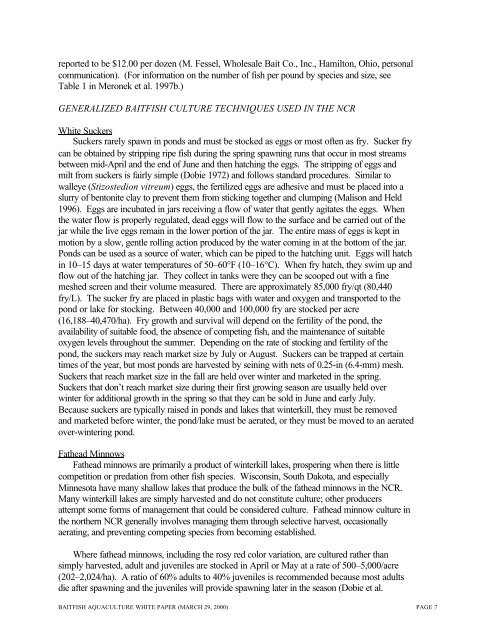a white paper on the status and needs of baitfish ... - NCRAC
a white paper on the status and needs of baitfish ... - NCRAC
a white paper on the status and needs of baitfish ... - NCRAC
Create successful ePaper yourself
Turn your PDF publications into a flip-book with our unique Google optimized e-Paper software.
eported to be $12.00 per dozen (M. Fessel, Wholesale Bait Co., Inc., Hamilt<strong>on</strong>, Ohio, pers<strong>on</strong>al<br />
communicati<strong>on</strong>). (For informati<strong>on</strong> <strong>on</strong> <strong>the</strong> number <strong>of</strong> fish per pound by species <strong>and</strong> size, see<br />
Table 1 in Mer<strong>on</strong>ek et al. 1997b.)<br />
GENERALIZED BAITFISH CULTURE TECHNIQUES USED IN THE NCR<br />
White Suckers<br />
Suckers rarely spawn in p<strong>on</strong>ds <strong>and</strong> must be stocked as eggs or most <strong>of</strong>ten as fry. Sucker fry<br />
can be obtained by stripping ripe fish during <strong>the</strong> spring spawning runs that occur in most streams<br />
between mid-April <strong>and</strong> <strong>the</strong> end <strong>of</strong> June <strong>and</strong> <strong>the</strong>n hatching <strong>the</strong> eggs. The stripping <strong>of</strong> eggs <strong>and</strong><br />
milt from suckers is fairly simple (Dobie 1972) <strong>and</strong> follows st<strong>and</strong>ard procedures. Similar to<br />
walleye (Stizostedi<strong>on</strong> vitreum) eggs, <strong>the</strong> fertilized eggs are adhesive <strong>and</strong> must be placed into a<br />
slurry <strong>of</strong> bent<strong>on</strong>ite clay to prevent <strong>the</strong>m from sticking toge<strong>the</strong>r <strong>and</strong> clumping (Malis<strong>on</strong> <strong>and</strong> Held<br />
1996). Eggs are incubated in jars receiving a flow <strong>of</strong> water that gently agitates <strong>the</strong> eggs. When<br />
<strong>the</strong> water flow is properly regulated, dead eggs will flow to <strong>the</strong> surface <strong>and</strong> be carried out <strong>of</strong> <strong>the</strong><br />
jar while <strong>the</strong> live eggs remain in <strong>the</strong> lower porti<strong>on</strong> <strong>of</strong> <strong>the</strong> jar. The entire mass <strong>of</strong> eggs is kept in<br />
moti<strong>on</strong> by a slow, gentle rolling acti<strong>on</strong> produced by <strong>the</strong> water coming in at <strong>the</strong> bottom <strong>of</strong> <strong>the</strong> jar.<br />
P<strong>on</strong>ds can be used as a source <strong>of</strong> water, which can be piped to <strong>the</strong> hatching unit. Eggs will hatch<br />
in 10–15 days at water temperatures <strong>of</strong> 50–60°F (10–16°C). When fry hatch, <strong>the</strong>y swim up <strong>and</strong><br />
flow out <strong>of</strong> <strong>the</strong> hatching jar. They collect in tanks were <strong>the</strong>y can be scooped out with a fine<br />
meshed screen <strong>and</strong> <strong>the</strong>ir volume measured. There are approximately 85,000 fry/qt (80,440<br />
fry/L). The sucker fry are placed in plastic bags with water <strong>and</strong> oxygen <strong>and</strong> transported to <strong>the</strong><br />
p<strong>on</strong>d or lake for stocking. Between 40,000 <strong>and</strong> 100,000 fry are stocked per acre<br />
(16,188–40,470/ha). Fry growth <strong>and</strong> survival will depend <strong>on</strong> <strong>the</strong> fertility <strong>of</strong> <strong>the</strong> p<strong>on</strong>d, <strong>the</strong><br />
availability <strong>of</strong> suitable food, <strong>the</strong> absence <strong>of</strong> competing fish, <strong>and</strong> <strong>the</strong> maintenance <strong>of</strong> suitable<br />
oxygen levels throughout <strong>the</strong> summer. Depending <strong>on</strong> <strong>the</strong> rate <strong>of</strong> stocking <strong>and</strong> fertility <strong>of</strong> <strong>the</strong><br />
p<strong>on</strong>d, <strong>the</strong> suckers may reach market size by July or August. Suckers can be trapped at certain<br />
times <strong>of</strong> <strong>the</strong> year, but most p<strong>on</strong>ds are harvested by seining with nets <strong>of</strong> 0.25-in (6.4-mm) mesh.<br />
Suckers that reach market size in <strong>the</strong> fall are held over winter <strong>and</strong> marketed in <strong>the</strong> spring.<br />
Suckers that d<strong>on</strong>’t reach market size during <strong>the</strong>ir first growing seas<strong>on</strong> are usually held over<br />
winter for additi<strong>on</strong>al growth in <strong>the</strong> spring so that <strong>the</strong>y can be sold in June <strong>and</strong> early July.<br />
Because suckers are typically raised in p<strong>on</strong>ds <strong>and</strong> lakes that winterkill, <strong>the</strong>y must be removed<br />
<strong>and</strong> marketed before winter, <strong>the</strong> p<strong>on</strong>d/lake must be aerated, or <strong>the</strong>y must be moved to an aerated<br />
over-wintering p<strong>on</strong>d.<br />
Fa<strong>the</strong>ad Minnows<br />
Fa<strong>the</strong>ad minnows are primarily a product <strong>of</strong> winterkill lakes, prospering when <strong>the</strong>re is little<br />
competiti<strong>on</strong> or predati<strong>on</strong> from o<strong>the</strong>r fish species. Wisc<strong>on</strong>sin, South Dakota, <strong>and</strong> especially<br />
Minnesota have many shallow lakes that produce <strong>the</strong> bulk <strong>of</strong> <strong>the</strong> fa<strong>the</strong>ad minnows in <strong>the</strong> NCR.<br />
Many winterkill lakes are simply harvested <strong>and</strong> do not c<strong>on</strong>stitute culture; o<strong>the</strong>r producers<br />
attempt some forms <strong>of</strong> management that could be c<strong>on</strong>sidered culture. Fa<strong>the</strong>ad minnow culture in<br />
<strong>the</strong> nor<strong>the</strong>rn NCR generally involves managing <strong>the</strong>m through selective harvest, occasi<strong>on</strong>ally<br />
aerating, <strong>and</strong> preventing competing species from becoming established.<br />
Where fa<strong>the</strong>ad minnows, including <strong>the</strong> rosy red color variati<strong>on</strong>, are cultured ra<strong>the</strong>r than<br />
simply harvested, adult <strong>and</strong> juveniles are stocked in April or May at a rate <strong>of</strong> 500–5,000/acre<br />
(202–2,024/ha). A ratio <strong>of</strong> 60% adults to 40% juveniles is recommended because most adults<br />
die after spawning <strong>and</strong> <strong>the</strong> juveniles will provide spawning later in <strong>the</strong> seas<strong>on</strong> (Dobie et al.<br />
BAITFISH AQUACULTURE WHITE PAPER (MARCH 29, 2000) PAGE 7


